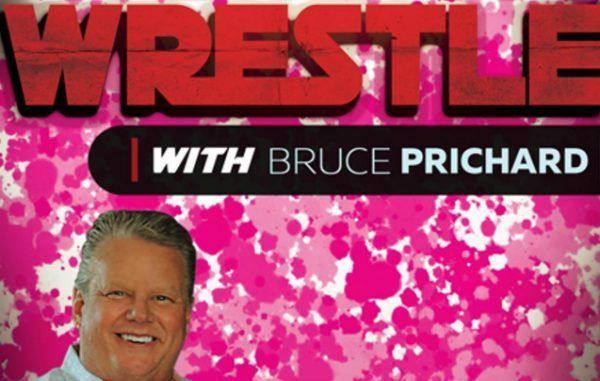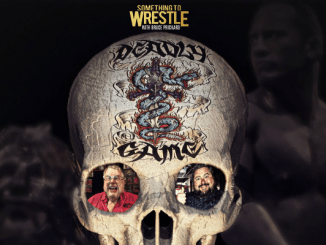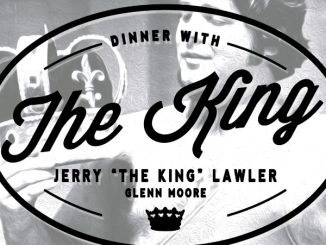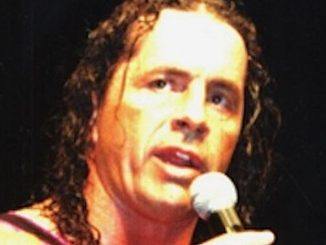
Something To Wrestle With – Hulk Hogan’s 1988
Release Date: June 1, 2017
Recap by: Jeff Rush
DIRECT LINK TO LISTEN/DOWNLOAD
Highlights (full timestamps at the end):
– There were several practice runs done prior to the first Royal Rumble. Don Muraco won them all.
– Pat Patterson invented the Rumble concept, envisioning it as a “reverse battle royal.”
– Though NBC’s The Main Event set ratings records, it was very poorly attended live.
– Andre the Giant hated Brother Love and wasn’t always able to separate him from Bruce Prichard.
– Hogan refused to work with Dustin Rhodes in the early ’90s.
– Nikolai Volkofftraveledd with his own hot plate and scavenged for over ripe produce at supermarkets.
– Bruce recites the Soviet National Anthem.
– Hogan witnessed international riots on TV and it inspired him to pitch getting beat up by the Big Boss Man.
Top Impressions
9. Vince explains the difference between Saturday Night’s Main Event and The Main Event
8. Andre wants the night off
7. Dusty explains why the Bunkhouse Stampede is superior to the Rumble
6. The only thing Macho Man loves more than Honky Tonk Man not dropping the IC title is shaving products
5. Vince offers his congratulations on the birth of Hulk’s daughter.
4. Vince produces the Mega Powers handshake
3. Jerry Jarrett describes the Conquistadors
2. Jim Cornette always has a spare key
1. Pat Patterson pitches the Royal Rumble concept
What happened when the calendar turned to 1988 for Hulk Hogan?
1987 was a huge year for the WWF including WrestleMania III and the release of the Piledriver album.
SummerSlam and the Royal Rumble were both created in 1988.
Hogan was feuding with One Man Gang at the start of 1988. Conrad wonders why Gang didn’t stick around longer. Bruce says everyone loved working with him and was a great guy, but that he just got tired of the travel.
Conrad preferred the Akeem character over the One Man Gang. He says that’s basically his dad.
Hogan was responsible for getting the Honky Tonk Man into the WWF. Hogan had seen Wayne Farris doing the Elvis gimmick in Canada and wanted to bring him in. Vince saw Honky as a babyface.
Hogan and Rick Rude didn’t work together very much. Bruce feels it was just due to a clash of styles and nothing else.
Hogan then began working with the Million Dollar Man Ted Dibiase. Bruce feels Dibiase was an 11 on a scale of 1-10.
This brings us to the first Royal Rumble. Conrad points out that there were three practice runs in the weeks leading up to the actual show. Don Muraco won all three unofficial Rumbles. These matches were done to let guys get used to the format and see how it got over with crowds. Two of these practice runs were called “Bunkhouse Battle Royals.” Conrad points out that the actual Rumble is running head to head with JCP’s Bunkhouse Brawl. The fact that Bunkhouse Brawl was run in Long Island was seen as an act of war by WWF. Conrad points out how ridiculous it is to say such a thing considering WWF invented the Survivor Series just two months earlier to kill the NWA’s Starrcade.
Bruce says the idea for the match was Pat Patterson’s, that he saw it as a “reverse battle royal.” He says it didn’t work out very well the first time through. Bruce adds that the Royal Rumble broadcast was the first live show he’d ever written.
Bruce claims the Rumble was not only a way for the WWF to compete with the NWA, it was broadcast on the USA Network and was a way for them to compete with Turner’s channels.
Conrad points out that the Royal Rumble was the second show the wrestlers had worked that day and that they’d worked twice the day before. This brings us to a discussion on the brutal travel schedule in wrestling at the time.
The following are quotes posted in the Quick Quotes feature on PWPodcasts.com the day this episode first aired:
“It sucked. It was a grind. It was an absolute grind. People ask about the drugs and the lifestyle of a professional wrestler back in the day and, I hate to say drugs were a necessity, but they were an every day part of our life because you took something to get up and then you took something to keep going and then, at the end of the night, you needed something to wind yourself back down to get a couple hours of sleep to get up in the morning to take something else to go do it all over again and it became a vicious cycle.”
Conrad thanks Bruce for bringing up the subject and points out that such drug use will not be celebrated or advocated on the show. He says he’s heard other people describe the lifestyle similarly in the past, but never specifics. What does a person take when going through such a cycle?
“Take a handful of speed, caffeine, man. Take a ton of ephedrine. Some guys snorted cocaine.”
“So you do that as soon as you wake up and then you need something before you work out. What would that be?”
“Same thing.”
“And then you would get ready for your match? Are you going to do anything there?”
“Again, same thing. A lot of ephedrine, those white crosses, you know, that the truckers always took. A lot of that going on. A lot of speed.”
And after the match?
“You go grab a beer and maybe take some muscle relaxers and pain killers and smoke a few joints. You’ve got to wind down and relax.”
In the ’90s, somas were big. What about the ’80s?
“Pain pills. Percocet. Vicodin came a little after that, in the ’90s. Meanie greenies. It’s funny, I was with a gentleman from Major League Baseball last night and was talking to him, similar to what we’re talking about now and he went through the list of the ballplayers and, no s**t, same conversation you and me are having right now, but him talking about meanie greenies and quaaludes and the old drugs from the late ’70s and early ’80s that we did and that was a way of life. Whatever was en vogue at the time and whatever would help ail you.”
And at the end of the night, after the drinking. What’s doing the trick in the ’80s?
“Halcion.”
Does Bruce blame the schedule, at least in part, for this drug usage?
“You’ve got a choice. You don’t have to do it. You can get through it and you can muscle your way through it. There were those of us that had a choice and, speaking for myself, I chose to just say ‘well, hell, if I take this, I’ll feel better, so I’m going to take that.”
“Can you point to one person who you know was clean as a whistle 24/7, never did s**t but Diet Coke?”
“George Gray, One Man Gang. There were probably a few of them, but there were probably more of us that were looking for help, but I’ve never known him to do anything.”
Hogan and Andre held a contract signing for their match on NBC’s Main Event at the Rumble. It was a first on WWF TV. Bruce says the whole idea for the Rumble broadcast was to be a collection of attractions instead of match after match. Thusly, we had the contract signing and Dino Bravo’s bench press display.
Next up is the famed Main Event on Feb. 5th from Indianapolis, where Andre the Giant would challenge Hulk Hogan for the title on free TV. Conrad mentions the live attendance for this show was terrible.
This was the first time in 33 years wrestling was featured on network TV in prime time. The guys talk about what a big deal this was. We then go on to talk about Dick Ebersol from NBC, his involvement with Saturday Night’s Main Event and his relationship with Vince McMahon.
Honky Tonk Man recently did an interview where he discussed not being willing to drop the IC title. He was worried Vince was planning to write him off. Additionally, he was advised by Jim Barnett not to lose on the Main Event since the show was going to be so big. He ended up not doing the job on this show.
The Main Event got a 15.2 rating. Bruce says the feeling was euphoria. Conrad talks again about the craziness of having 33 million people watch the show on TV, but less than 15,000 showing up in person. Even though it was incredibly successful, it took over a year for WWF to run another Main Event. Bruce says they were handed excuses by the network as to why that was, but Conrad thinks someone with NBC wasn’t into wrestling and had their own agenda.
The backstory for the show is that Ted DiBiase wanted to buy the title from Hogan and was denied. His plan B was to hire the services of Andre, have him defeat Hogan and then purchase the title from him.
Conrad then geeks out on the Winged Eagle title belt. It was unveiled on this night and would be featured prominently throughout the ’90s.
Ted and Virgil created a lot of movement through outside interference in this match to mask Andre’s inability to do much physically at this point. Andre pinned Hogan even though Hogan’s shoulder was up at the count of one. Andre then announced he is forfeiting the title to Ted Dibiase.
Bruce sidetracks into being terrified of working with Andre back then. He says he got along well with him, but that Andre hated the Brother Love character and it was hard for him to separate the two.
The “evil ref” plot unfolds as Earl Hebner is introduced as an imposter. The storyline is that Dave Hebner was tied up backstage and DiBiase paid someone else to have plastic surgery to look like Dave and screw Hogan out of the title.
The guys talk about how this was one of the best angles ever. Conrad loved watching it and Bruce was thrilled to be a part of it. Vince was extremely happy about everything when he returned to the locker room that night as well.
We talk a bit more about the Hebner brothers. They were twin referees working in the industry since the ’70s. Dave was transitioning into being an agent and Earl was coming over from the NWA. Bruce would get them confused for a long time. He says both brothers were problem solvers, could find you a good deal or a cold beer.
DiBiase was introduced at house shows that weekend as the World Champion.
Bruce mentions that Hogan did not want to work with Dustin Rhodes in the early ’90s. He says Hogan didn’t think he was in the greatest of shape at the time nor did he have high-profile status. Conrad calls BS on this and says Hogan was threatened by Dustin’s youth and family legacy.
WWF would run a house show at the Silverdome in Pontiac, MI – the site of WrestleMania III a year earlier and only drew 12,000 fans. Bruce says they ran there because it was cheap.
Hogan then ran Hollywood, FL main-eventing against “The Natural” Butch Reed, and we get this exchange:
CT: Why was Butch Reed working with Hogan on this particular show in Florida?
BP: Because it’s close to Hogan’s home.
CT: Well, because Butch Reed’s over in Florida. I mean good lord. Florida Championship Wrestling, Butch Reed’s from Florida. He was drawing houses down there and having great matches.
BP: Yeah, that was a long time ago. That was a LONG ASS time ago.
CT: We’re talking about a show that happened 29 years ago.
BP: I understand that, but Butch had left Florida long before that and gone through Mid-South and been in-
CT (considerably worked up): Ok, then answer this, smarty. Why is Butch Reed working against Hulk Hogan in Florida?
BP: Because they wanted to see how Butch would do, if people were buying him.
CT: Why didn’t they do it in Detroit?
(long pause)
BP: Because Butch was over in Florida.
I love this show.
Hogan travels from Hollywood, FL to Denver to Idaho in three consecutive days. They discuss the WWF’s event booker at the time, Ed Cohen. He would get the blame when wrestlers schedules were all over the map. Cohen would have fun with this by keeping a map of the US on his office wall and darts on his desk.
Hogan then worked a short match against Harley Race on Saturday Night’s Main Event. Race crashed through a table and ended his career. Bruce says he remembers it because it happened on his (Bruce’s) birthday. He notes that Vince took care of Harley after the fact.
Bruce knew in December of 1987 that they’d be going with a tournament format at WrestleMania IV.
Conrad brings up that WWF ran back-to-back WrestleMania’s at Trump Plaza. Bruce says they got a good deal and it was close to home so they knew they would make money. The casino bought up the seats as part of the deal and hotel expenses were also absorbed. Conrad says taking all that into consideration, he would do it every year.
Bruce says Trump was an ideal partner for running such an event because he’s such a publicity whore. He goes on about how much Trump looked up to Vince and Conrad calls BS on that.
Hogan and Andre were given a first-round bye in the tournament and were both DQ’d in the second round. Bruce says the idea behind the promotion for this Mania was “Hulk-Andre III.” He says WMIII was the first, the first Survivor Series was Andre getting his win back in a tag team match, then Andre goes over in the Main Event and now this. By eliminating both guys, they felt they could get one more big ticket match out of them.
Hogan came out to help Randy Savage in the main event. Bruce says this was an attempt to sprinkle “Hogan dust” on Randy. They had a pretty good idea of where things were headed for WrestleMania V at this point.
Hogan was then off to film No Holds Barred.
Talk shifts to one of Conrad’s favorite wrestlers – Nikolai Volkoff. Bruce says he was a legit bad ass and underrated. He then talks about Volkoff’s frugal nature. Apparently, Nikolai would travel with a hot plate and cookware. He’d also go to local grocery stores and collect produce that was set to be thrown out. He’d buy cheap meat and proceed to stink up his hotel by cooking in his room.
Conrad asks Bruce to recite Nikolai’s rendition of the Soviet National anthem. I will interject that, since the ’80s, I have known this song. I don’t speak Russian, I haven’t heard the actual anthem, but I’ve listened to Nikolai Volkoff sing it so many times, I know the exact cadence. Bruce actually nails it pretty closely. Of course, he seems to add in an “eat my crotch” or something to that effect at the end of both phrases. It’s pretty good stuff.
Around this time, Brooke Hogan was born. Vince gifted an engraved baby dumbbell to Hulk and family.
In preparation for the first SummerSlam, Hogan enlists the help of Randy Savage. On an episode of the Bother Love show, the two are anointed the Mega Powers. Bruce loved working with both guys, says it was like a night off.
Hogan always referred to DiBiase as “the Mega Million Dollar Man.” Bruce says this is because that’s more evil that a regular Million Dollar Man.
Bruce says Hogan was pretty easy to work with at this point in his career. He was hit with a few “that doesn’t work for me” from time to time, but nothing crazy.
Conrad mentions a Hogan-Andre match is Greensboro, NC drew 3,600 fans.
He would then run Toronto against Bad New Brown on the night before SummerSlam that brought out 18,000.
This segues us into the story about Andre using an offensive slur on Bad News. Bad News stepped up to Andre, but Andre didn’t want to fight him. Bruce then tells a story that sounds like a joke at first involving Andre losing control of his bowels on Bad News chest. It’s a rough listen.
SummerSlam ‘88 was a sellout at Madison Square Garden. The Main Event saw the Mega Powers battle the Mega Bucks (DiBiase and Andre). Jesse Ventura was the guest referee.
Bruce discusses briefly Hogan and Ventura having issues over Ventura’s attempts to create a wrestlers union and Hogan tipping off Vince, who squashed it.
Conrad points out the similarities between the main event at the first WrestleMania and that at the first SummerSlam. Both were tag matches involving Hogan. Both had guest referees. Bruce says both were designed to be national attractions without giving away anything that was still making money on the house show circuit.
The finish of the match saw Miss Elizabeth remove her skirt and distract the heels. Savage hits the elbow, Hogan hits the leg drop, Hogan must pose.
The guys talk about how racy the whole thing seemed at the time, but that it was really no big deal in hindsight. Bruce says it was a red one-piece Liz was wearing that was not revealing at all. Conrad calls them granny panties. He says it’s crazy that a decade later, WWF has women on their shows full on exposing themselves.
Hogan then began his program with the Big Boss Man. This includes Boss Man’s attack on Hogan during an episode of the Brother Love Show.
The angle was Hulk’s idea. Hogan had seen a riot scene somewhere in Europe where the cops were beating helpless people with their billyclubs. He cast Boss Man as those ruthless cops, and himself as the helpless public. So weird.
Bruce says they shot the scene of Hogan getting beat down by Boss man and had to do it a second time. Vince felt Hogan had sold the beating too much. Additionally, they created the illusion of movement with the cameras to make the scene livelier.
Conrad mentions there was a King Of The Ring 1988, that was won by Ted Dibiase. Bruce says the show was just a house show deal in Providence, RI for years.
Conrad then gets into the WWF intentionally running their biggest match – Hogan-Andre in the heart of WCW territory, Atlanta, GA. It happened at the Omni and only drew 5,200 fans. Bruce says when poorly attended events would take place, the office would blame the wrestlers and the wrestlers would blame the office. He says, ultimately, in this case, no one wanted to see this match.
Hogan then drew only 2,100 in Hershey, PA in a card loaded with talent. Conrad says this kills the narrative of “sold out every night, hanging from the rafters, brother.” This is probably around the time, listening to the episode, that Hogan decided to block Conrad on Twitter.
Conrad lays into Bruce for what he feels is his inability to blame Vince McMahon for doing something poorly. Bruce is hesitant throughout this conversation to say the poor draws were the office’s fault. Conrad eventually gets him to admit the match had already been given away for free on TV and that no one was interested.
“So the office f**ked it up.” Conrad rests his case.
The guys then argue about ratings based on the time of day programming airs.
The Mega Powers had a big handshake angle that took place on the Brother Love Show. It turned out to be the beginning of the end of the team as they worked their way towards WrestleMania V.
On another episode of the Brother Love Show, Hogan knocks Bruce over the top rope with a clothesline. Conrad points out that it looked like a painful bump. “Light as a feather,” says Bruce. He’d been shown how to take the bump by Marty Jannetty earlier in the day and was initially scared to death to do so.
We get through Survivor Series with Hogan’s program with Randy building further. Conrad reminds us that this is covered in detail in the Mega Powers episode recorded very early on in STWW’s run.
Hogan closed out 1988 working back to back shows against Boss Man.
The guys recall Hogan’s big moment from 1988 being the Main Event back in February. Bruce calls it the greatest finish he’s ever seen. The drawing power of Hogan made Bruce’s first full year in the company unbelievable. Hogan was larger than life.
Rating – 7/10
I understand the reasoning behind cordoning off the career of a huge superstar like Hulk Hogan year-by-year when working with the format this show does. There’s a lot to tell and I am fully in favor of tackling the larger subjects in this manner. There’s just so much minutia that would be lost to time if Conrad didn’t go through and dissect everything. That said, this gigantic, significant year in the career of Hulk Hogan was perhaps given 30-45 minutes more than it needed. Depending on your interests, this could be good or bad. If you’re all about the details of cable deals, ratings, the ins-and-outs of booking cities and arenas, and, of course, title belts, this is your episode. I’m definitely into those subjects, but the show seemed a bit top heavy in that regard with not quite as much given to the juicier aspects that drive this show – the quelling of “rumor and innuendo” and all the unseen backstage mechanics that create the movement we see on TV. Admittedly, you can only address that which exists. All that factored in, the guys did a tremendous job of turning Hulk Hogan’s calendar year inside out. This perhaps wasn’t the grand slam so many of these shows are, but if you’re a fan of WWF 1980’s wrestling and, specifically, grew up on Hulk Hogan, there’s a ton to be gotten from this episode. I do look forward to Hogan ’89.
Timestamps:
9:45: Show begins
10:24: One Man Gang
14:11: Honky Tonk Man
15:19: Rick Rude
16:52: Million Dollar Man
18:01: The first Royal Rumble
27:51: Travel schedule
30:26: Drug use in wrestling
36:00: Hulk-Andre contract signing
38:38: House shows post-Rumble
41:00: The Main Event
48:58: Honky won’t drop the IC title
1:04:08: Winged Eagle belt
1:07:26: Hogan-Andre finish
1:08:54: Andre hates Brother Love
1:09:44: Twin Referees
1:17:32: Dibiase as Champion
1:19:02: Young Dustin Rhodes
1:20:35: Mad Dog Vachon
1:22:49: Butch Reed is over in Florida
1:28:05: Harley Race’s last match
1:29:20: Real American video
1:31:40: The Killer Bees
1:33:00: Mad Dog tribute show
1:34:00: Consecutive WM’s at the same venue
1:38:11: Bob Uecker
1:38:30: WrestleMania IV
1:42:40: No Holds Barred
1:43:45: Nikolai Volkoff
1:47:02: Brooke Hogan is born
1:48:40: The Conquistadors
1:50:10: Hogan-Savage pairing
1:53:51: Wrestlefest 88
2:00:45: Hogan’s opponents payouts
2:02:35: Bad News/Andre incident and other Andre tales
2:06:36: SummerSlam 88
2:08:37: Problems with Ventura
2:14:10: Liz bikini finish
2:17:20: Big Boss Man
2:22:15: Hogan debuts in Edmonton
2:23:04: King Of The Ring 88
2:23:33: Hogan drawing poorly
2:32:01: Mega Powers handshake
2:37:59: Bruce takes a huge bump from Hulk
2:40:06: Survivor Series 88
2:41:51: Mega Powers disintegrate
2:49:01: Bruce ranks Hogan 88




Be the first to comment